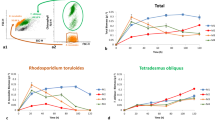Abstract
Microcalorimetry was employed to investigate the action of Li(I) to aquatic ecosystem from the point view of bioenergetics. Tetrahymena thermophila BF5 was chosen as the model organism. The power-time curves of T. thermophila BF5 growth metabolism in the absence and presence of Li(I) were obtained. The corresponding thermokinetic parameters were derived. The generation time was calculated as 592.3 min, which was consistent with the biomass values. Low concentration of Li(I) (1–20 mmol l−1) stimulated the growth of T. thermophila BF5, whereas the inhibition effect was observed in high concentration (30–100 mmol l−1). The value of IC50 was 52.8 mmol l−1. In the concentration range of 30–100 mmol l−1, the growth rate constants (k) and the maximum heat out power (P max) decrease with the concentration of Li(I), whereas the heat output (Q) increases slightly compared to the control. Other than the classic mechanism of inositol-phosphate cycle, the involvement of mitochondria mechanism was discussed and suggested.




Similar content being viewed by others
References
Nicholas JB (1999) Inorganic pharmacology of lithium Chem Rev 99:2659–2682
Pilcher HR (2003) The ups and downs of lithium. Nature 425:118–120
Knijff EM, Ruwhof C, De Wit HJ, Kupka RW et al (2006) Monocyte-derived dendritic cells in bipolar disorder. Biol Psychiatry 59:317–326
Rybakowski JK (2000) Antiviral and immunomodulatory effect of lithium. Pharmacopsychiatry 33:159–164
Kniff EM, Kupka RW, Ruwhof C, Breumis MN et al (2005) Evidence that the immunopathogenic mechanism of lithium-induced psoriasis differs from that of regular psoriasis. Bipolar Disord 7:388–389
Liu YY, Pluijm G, Karperien M, Stokkel MPM et al (2006) lithium as adjuvant to radioiodine therapy in differentiated thyroid carcinoma: clinical and in vitro studies. Clin Endocrinol 64:617–624
Beurel E, Kornprobst M, Eggelpoel MJB, Ruiz-Ruiz C et al (2004) GSK-3β inhibition by lithium confers resistance to chemotherapy-induced apoptosis through the repression of CD95 (Fas/APO-1) expression. Exp Cell Res 300:354–364
Koong SS, Reynolds JC, Movius EG, Keenan AM et al (1999) Lithium as a potential adjuvant to I-131 therapy of metastatic, well differentiated thyroid carcinoma. J Clin Endocrinol Metab 84:912–916
Kszos LA, Stewart AJ (2003) Review of lithium in aquatic environment: distribution in the United States, toxicity and case example of groundwater contamination. Ecotoxicology 12:439–447
Kszos LA, Beauchamp JJ, Stewart AJ (2003) Toxicity of lithium to three freshwater organisms and the antagonistic effect of sodium. Ecotoxicology 12:427–437
Lee SR, Collins K (2005) Starvation-induced cleavage of the tRNA anticodon loop in Tetrahymena thermophila. J Biol Chem 280:42744–42749
Dondero F, Cavaletto M, Ghezzi AR (2004) Biochemical characterization and quantitative gene expression analysis of the multi-stress inducible metallothionein from Tetrahymena thermophila. Protist 155:157–168
Eisen JA, Coyne RS, Wu M, Wu DY et al (2006) Macronuclear genome sequence of the ciliate Tetrahymena thermophila, a model eukaryote. PLoS Biol 4:1620–1642
Moya CE, Jacobs RS (2006) Pseudopterosin A inhibits phagocytosis and alters intracellular calcium turnover in a pertussis toxin sensitive site in Tetrahymena thermophila. Comp Biochem Physiol Part C Toxicol Pharmacol 143:436–443
Sullivan WJ, Naguleswaran A, Angel SO (2006) Histones and histone modifications in protozoan parasites. Cell Microbiol 8:1850–1861
Power ME, Sotornik D, Pinheiro MDO, Dayeh VR, Butler BJ et al (2006) Development of a fluorescent multiwell assay for evaluating the capacity of the ciliated protozoan Tetrahymena for bacterivory in water samples. Water Qual Res J Can 41:307–315
Dayeh VR, Grominsky S, DeWitte-Orr SJ, Sotornik D (2005) Comparing a ciliate and a fish cell line for their sensitivity to several classes of toxicants by the novel application of multiwell filter plates to Tetrahymena. Res Microbiol 156:93–103
Wright JC, Westh P (2006) Water vapour absorption in the penicillate millipede Polyxenus lagurus (Diplopoda: Penicillata: Polyxenida): microcalorimetric analysis of uptake kinetics. J Exp Biol 209:2486–2494
Nunez-Regueira L, Rodriguez-Anon JA, Proupin-Castineiras J, Nunez-Fernandez O (2006) Microcalorimetric study of changes in the microbial activity in a humic Cambisol after reforestation with eucalyptus in Galicia (NW Spain). Soil Biol Biochem 38:115–124
Prado AGS, Airoldi C (2001) The effect of the herbicide diuron on soil microbial activity. Pest Manag Sci 57:640–644
Kaya A (2004) Characterization of clay particle surfaces for contaminant sorption in soil barriers using flow microcalorimetry. J Environ Eng 130:918–921
Robert HC, Joseph JM, Show HD, Joan MA, John CT (2003) Clinical performance characteristics of a new photometric lithium assay: a multicenter study. Clin Chim Acta 327:157–164
Camus M, Hennere G, Baron G, Peytavin G et al (2003) Comparison of lithium concentrations in red blood cells and plasma in samples collected for TDM, acute toxicity, or acute-on-chronic toxicity. Eur J Clin Pharmacol 59:583–587
Maria JD, Joseph F (1995) The effects of lithium chloride on pattern formation in Tetrahymena thermophila. Dev Biol 171:497–506
Wadso L, Gomez F, Sjoholm I, Rocculic P (2004) Effect of tissue wounding on the results from calorimetric measurements of vegetable respiration. Thermochim Acta 422:89–93
Zheng D, Li(I)u Y, Zhang Y, Chen XJ, Shen YF (2006) Microcalorimetric investigation of the toxic action of Cr(VI) on the metabolism of Tetrahymena thermophila BF5 during growth. Environ Toxicol Pharmacol 22:121–127
Calabrese EJ (2005) Toxicological awakenings: the rebirth of hormesis as a central pillar of toxicology. Toxicol Appl Pharmacol 204:1–8
Calabrese EJ, Blain R (2005) The occurrence of hormetic dose responses in the toxicological literature, the hormesis database: an overview. Toxicol Appl Pharmacol 202:289–301
Phillip LW, Robert CJ, Stephen MR (2000) Principles of toxicology, 2nd ed. John Wiley & Sons, Inc., New York, p. 14
Schrauzer NG (2002) Lithium: occurrence, dietary intakes, nutritional essentiality. J Am Coll Nutr 21:14–21
Acknowledgment
This work was financially supported by the National Natural Science Foundation of China (No.30570015, 20472066 and 20373051), Science Fund for Creative Research Group (No.20621502 NSFC), Science Research Foundation of Chinese Ministry of Education (NO: [2006]8IRT0543), and Natural Science Foundation of Hubei Province (No.2005ABC02).
Author information
Authors and Affiliations
Corresponding author
Rights and permissions
About this article
Cite this article
Li, HR., Liu, Y., Qin, CQ. et al. Bioenergetic Investigation of Action of Lithium to Tetrahymena thermophila bF5 by Microcalorimetry. Biol Trace Elem Res 119, 60–67 (2007). https://doi.org/10.1007/s12011-007-0040-x
Received:
Accepted:
Published:
Issue Date:
DOI: https://doi.org/10.1007/s12011-007-0040-x




